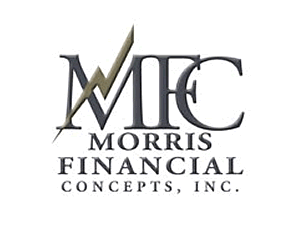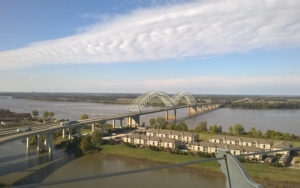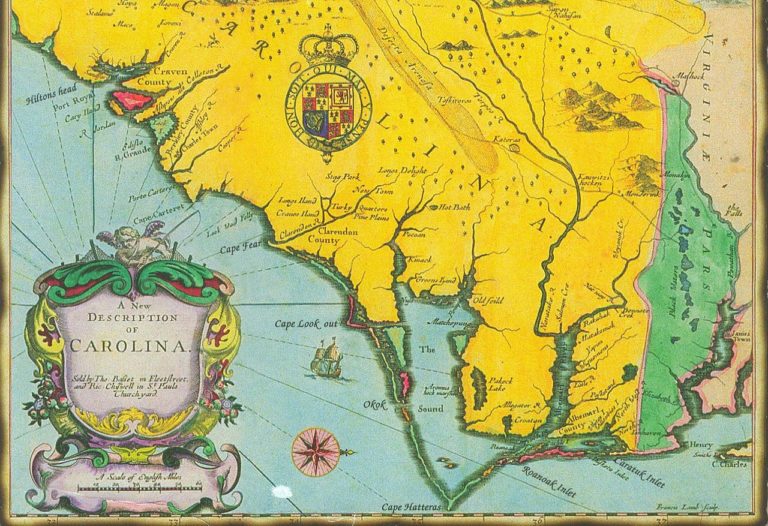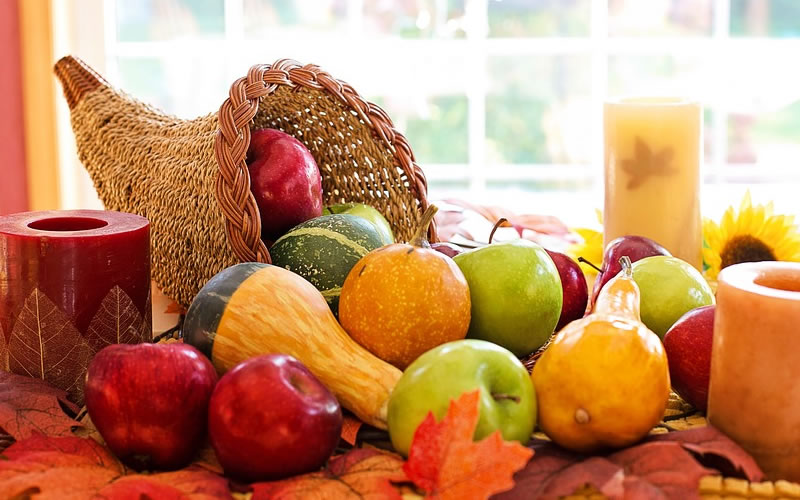FOCUS: Looking back at Thanksgiving in early Charleston
COMMENTARY, Brack: Some tonics to soothe an unhappy America
IN THE SPOTLIGHT: Morris Financial Concepts, Inc.
GOOD NEWS: Homegrown Holiday Bazaar set for Dec. 1 on Johns Island
FEEDBACK: Great photo essay
MYSTERY PHOTO: Who is this guy?
S.C. ENCYCLOPEDIA: Carolina, the 1663 ship
CALENDAR: ARC’s Blood Battle is on
FOCUSFOCUS: Looking back at Thanksgiving in early Charleston
Editor’s note: Today’s Focus is an excerpt of an article by Charleston County Public Library’s historian, Dr. Nic Butler. We thought you’d appreciate it. To read the full article, click here.
By Dr. Nic Butler, reprinted with permission | It’s Thanksgiving season again, and for most people that means a day of rest, relaxation and feasting with close friends and family. As a historian working in an old city, I have learned that Thanksgiving also includes at least ten people asking me the same question: “When was the first Thanksgiving in Charleston?” I don’t mind the question at all, but the answer is generally more complex than most people care to hear. …
The tradition of Thanksgiving existed long before the creation of the United States, and it wasn’t just celebrated by the “pilgrims” of early Massachusetts. Spanish explorers in the Americas, for example, celebrated an annual day of thanksgiving in the early 1500s. French adventurers who settled briefly at Parris Island, South Carolina, celebrated a day of thanksgiving in 1564. English settlers at Jamestown, Virginia held a day of thanksgiving after their safe arrival in 1607. In short, the concept of setting aside an annual day for prayers of thanksgiving was a very common, international practice in the New World during the Age of Discovery.
 With these facts in mind, let’s return to our original question. The first settlers of the English colony of Carolina arrived here in 1670 and established their headquarters at Charles Town, on the west bank of the Ashley River. When was their first public celebration of thanksgiving in Charles Town? I regret to say that I’m not quite sure of the exact date, owing to the incomplete nature of the records of our early government here. If you’ll permit me to hazard an educated guess, however, I’d wager that the first English settlers who arrived at Charleston in the late spring of 1670 celebrated a day of thanksgiving before the end of that year. They probably didn’t celebrate and relax right away because they needed to build shelters and plant crops, but perhaps six months later, say, in November 1670, after surviving the initial adventures associated with launching a new colony, I suspect they finally treated themselves to a day of rest and thanksgiving. …
With these facts in mind, let’s return to our original question. The first settlers of the English colony of Carolina arrived here in 1670 and established their headquarters at Charles Town, on the west bank of the Ashley River. When was their first public celebration of thanksgiving in Charles Town? I regret to say that I’m not quite sure of the exact date, owing to the incomplete nature of the records of our early government here. If you’ll permit me to hazard an educated guess, however, I’d wager that the first English settlers who arrived at Charleston in the late spring of 1670 celebrated a day of thanksgiving before the end of that year. They probably didn’t celebrate and relax right away because they needed to build shelters and plant crops, but perhaps six months later, say, in November 1670, after surviving the initial adventures associated with launching a new colony, I suspect they finally treated themselves to a day of rest and thanksgiving. …
To my knowledge (which is certainly not exhaustive or comprehensive, of course), the earliest recorded observance of a day of public thanksgiving in the English colony of South Carolina occurred on 17 October 1706, which was approximately six weeks after our militia forces defeated an invasion force of Spanish and French soldiers from St. Augustine, Florida. The Rev. Francis LeJau, a missionary from England who arrived in Charleston on the 18th of October 1706, noted in a letter that “Upon my first Landing I saw the Inhabitants rejoycing: they had kept the day before holy for a thanksgiving to Almighty God for being safely delivered from an Invasion from the French and Spaniards. …”
The early notion of the “day of thanksgiving” was a moveable feast, if you will, that might be held at any point in the calendar year. Furthermore, this “day of thanksgiving” was customarily proclaimed at the local level—by the governor of a colony (later state governors) or the mayor of a city or town. Immediately after the formation of the Federal Government of the United States of America in 1789, however, our presidents—beginning with George Washington—also got into the habit of proclaiming public days of national thanksgiving. Around the middle of the nineteenth century, it became increasingly common for our presidents to proclaim a day of thanksgiving in the autumn months, a habit that reflected the New England tradition of an annual harvest celebration. It was President Abraham Lincoln who established the custom of placing this national holiday in late November of each year, but, contrary to some assertions, he did not create the modern concept of Thanksgiving.
Beginning with President Lincoln in 1863, each successive chief executive of the United States made an annual proclamation appointing the last Thursday in November as a national day of thanksgiving. That is to say, it was not a fixed holiday; it was a tradition, proclaimed anew each year, and, starting in 1863, was observed on a customary day of the year. It was a tradition enshrined at the highest level of our government, but no more than a tradition. Such was the case until the autumn of 1941, however, when President Franklin D. Roosevelt signed a law designating the third Thursday in November as a fixed national holiday, henceforth to be called “Thanksgiving Day.”
I started this conversation as an attempt to answer the question, “when was the first Thanksgiving in Charleston?” Now that you know the facts surrounding this topic, I hope you’ll understand that there are actually several ways to answer this question. The Native Americans who inhabited this area long before the arrival of Europeans may have observed their own sort of annual festival of thanks, for which we have no records. The earliest known “day of thanksgiving” in South Carolina was observed by French soldiers at Parris Island in Beaufort County in the year 1564. English settlers probably paused for a day of thanks shortly after establishing Charles Town on the Ashley River in 1670. The earliest recorded instance of a day of public thanksgiving in Charleston (that I know of) took place on 17 October 1706, to celebrate the survival of South Carolina in the face of invading enemies. And finally, the first celebration of the modern national holiday known as Thanksgiving Day took place on the third Thursday of November 1941, when everyone else in these United States celebrated that fixed national holiday for the first time. … Happy Thanksgiving, everyone!
- To read the full article, click here.
- Have a comment? Send to: editor@charlestoncurrents.com
BRACK: Some tonics to soothe an unhappy America
By Andy Brack, editor and publisher | The big takeaway from a month-long trip to 13 states during the midterm elections might sound simplistic, but it has a deeper meaning: the United States of America is an unhappy country.
 Unhappy because of the widening division between Republican and Democratic leaders, who often don’t seem like they can stand being in the same room.
Unhappy because of the widening division between Republican and Democratic leaders, who often don’t seem like they can stand being in the same room.
Unhappy because of people who don’t talk politics with new friends or coworkers for fear that they might be judged based on their politics – and lose a new acquaintance.
Unhappy because of a morbid obsession by the left and right with whatever President Donald Trump says on Twitter or what he does on any given day.
“People feel that they shouldn’t be feeling like that – that there should be a greater sense of oneness in their country and I think that has been a feature of America in times past,” observed Australian pundit Bruce Hawker who interviewed more than 130 people on the trip to make a documentary about the midterm elections.
“Now they miss that (oneness) and I think it’s a discombobulating feeling for a lot of Americans. They really feel affected adversely about it. I think they’re also exhausted by the constant conflict, and that’s not a good thing. I suspect it’s going to keep going for the next two years.”
Perhaps a big part of the problem is that people have been focused since the 2016 presidential primaries on the “America” part of the nation’s name, not the “united” part.
America has always been great, one South Carolinian told us during the filmmaking trip that stretched from Arizona to South Carolina to Minnesota to Pennsylvania. So, let’s work on the “united” part again.
Leaders in Congress should embrace bipartisanship. They need to show they can work together with issues that unite, not divide. Some examples:
Infrastructure. Let’s pass a measure to repair decaying infrastructure – the roads, bridges and physical structures that make commerce flow. After wildfires in the West, floods in the Northeast and hurricanes in the South, there’s lots of infrastructure work to be done to keep America competitive.
Criminal justice reform. There are signals the president and Congress are much closer to getting real criminal justice reform that would relax the tough sentencing requirements that warehoused tens of thousands of non-violent offenders in costly federal prisons. There are better ways to punish them without tearing apart families’ lives.
Living within our means. Congress needs to rein in spending and provide more balanced taxing so the country can live within its means. The alternative? Borrowing more billions from the Chinese, which puts our country more at risk.
Trade reform. While federal tariffs aren’t popular with businesses in big trading states like South Carolina, congressional leaders can work with the president to get better trade deals and enforce the laws on the books to protect the country’s economic backbone.
Immigration. Congress has worked for years on practical ways to reform legal immigration. Let’s focus on that to make progress, and not get caught up with the rancor of illegal immigration. Take baby steps on this issue to get some success.
The responsibility for soothing Americans and working to unite the country doesn’t rely only with government. The media and regular people need some reforming, too.
First, the media can chill out a little about every presidential tweet. In fact – and this won’t be popular in journalism circles – it might not be a bad idea for the White House press corps to stop going to daily briefings. The president already has an instant news channel (55.7 million Twitter followers). Instead of providing free coverage of daily White House rants, reporters could start covering more outside of the White House. In the cabinet agencies, there’s more than enough fodder.
Second, people at home and work could try to have more media-free time. If you can turn it off for a while, it might help you relax some.
Abraham Lincoln once said, “No matter how much cats fight, there always seem to be plenty of kittens.”
We may not need more kittens, but we need Congress to get along and do their job to unite the country.
- Have a comment? Send to: editor@charlestoncurrents.com
SPOTLIGHT: Morris Financial Concepts, Inc.
 The public spiritedness of our sponsors allows us to bring Charleston Currents to you at no cost to readers. Morris Financial Concepts, Inc., is a nationally recognized, fee-only financial consulting firm that helps you identify and align your resources, values and goals to achieve an enriched life.
The public spiritedness of our sponsors allows us to bring Charleston Currents to you at no cost to readers. Morris Financial Concepts, Inc., is a nationally recognized, fee-only financial consulting firm that helps you identify and align your resources, values and goals to achieve an enriched life.
We do not accept commissions or compensation related to the products and service we recommend. Our counsel is based solely on what we believe is best for each client.
- Learn about founder and Charleston Currentscolumnist Kyra Morris and more about the consultancy at: Morris Financial Concepts, Inc.
- To meet all of our underwriters, click here.
GOOD NEWS: Homegrown Holiday Bazaar set for Dec. 1 on Johns Island
Staff reports | The fifth annual Homegrown Holiday Bazaar will be held 10 a.m. to 4 p.m. Dec. 1 at islanders Farmers Market, 3546 Maybank Highway, on Johns Island. The event will serve as the farmers market for that day and is brought to you by the Islanders Farmers Market and Sea Islands Chamber of Commerce.
The bazaar will feature more than 100 vendors and farmers, just in time to get holiday shopping done from local businesses in support of your local economy. The Holiday Carriage and Hay Rides, Antique Tractor Show, Kiddie train ride, Pony Rides, and Santa & Mrs. Claus visits in Santa Land are sure to bring holiday cheer to all who visit!
Local food trucks will be on site along with warm drinks, local craft beer and wine. Ocean Drive Party Band of Charleston will be starting the day off with some great energy through 1 p.m. followed by Charleston’s own local musician White Jeep.
Activities for all ages include several seasonal-themed games, crafts, cookie decorating, ornament making, hula-hooping and bounce houses. There’s also a silent auction to support the operations of both hosting organizations.
- Admission is free and there is plenty of free parking on site. Some vendor spaces still are open. To find out more about the Homegrown Holiday Bazaar, call Karen Thompson at 843-793-1234 or visit www.seaislandschamber.org/holiday-bazaar.
Holiday travel tips. Charleston International Airport released several holiday travel tips that the organization thought Thanksgiving travelers might find helpful, particularly since nearly 100,000 people traveled in and out of the airport last year. Among the tips: Arrive early. Pack carry-on luggage wisely to facilitate your time in the security line; and allow plenty of time to find parking.
2018 Angels. Three Lowcountry charities made Secretary of State Mark Hammond’s annual list of charitable angels, including: Florence Crittenton Programs of South Carolina, Inc., Charleston; Good Neighbor Free Medical Clinic of Beaufort; and Helping Hands of Georgetown. The Angels honored represent organizations that exemplify charitable giving in South Carolina, according to a press release. Hammond also released the “2017-2018 Wise Giving & Professional Solicitor Report.” The report not only provides wise giving tips for donors, but also lists all professional solicitor contracts currently on file with the Secretary of State’s Office.
Port ambassadors. The S.C. Ports Authority last week announced its 2018-2019 Port Ambassadors class, consisting of 25 delegates who will complete a nine-month program that immerses participants into Port operations, economic development, and the maritime and transportation industry. The statewide program, launched in 2016 to increase public awareness and understanding of the ports, includes several local ambassadors: Johnny Cribb, City of Hanahan; Bill McCarthy, Charleston Gate Company; Tony Pope of Summerville, State Farm Insurance; Anne Smith Reid of Charleston, Association for the Blind and Visually Impaired – Charleston; and Tom Trouche of Charleston, ServisFirst Bank.
Giant Greeting Card Competition. Charleston County School of the Arts won first place in an annual design competition at the Holiday Festival of Lights among 37 entries. Other high school winners were Cathedral Academy (2nd) and Northside Christian Academy (3rd). Other division first-place winners were Summerville Catholic School (middle school); and Murray-LaSaine Elementary School. More info: HolidayFestivalofLights.com
FEEDBACK Great photo essay
Great photo essay
To the editor:
Awesome YALLFest coverage — Thank you to Ellie!!!!
— Jonathan Sanchez, Blue Bicycle Books, Charleston.
Send us your thoughts in two ways. We’d love to get your impact in one or more ways:
Send us a letter: We love hearing from readers. Comments are limited to 250 words or less. Please include your name and contact information. Send your letters to: editor@charlestoncurrents.com. | Read our feedback policy.
Tell us what you love about the Lowcountry. Send a short comment – 100 words to 150 words – that describes something you really enjoy about the Lowcountry. It can be big or small. It can be a place, a thing or something you see. It might the bakery where you get a morning croissant or a business or government entity doing a good job. We’ll highlight your entry in a coming issue of Charleston Currents. We look forward to hearing from you.
MYSTERYMYSTERY PHOTO: Who Is this guy?
Wonder if this guy looks familiar to you? Who is he and why should we care in South Carolina? Send your guess to: editor@charlestoncurrents.com. And don’t forget to include your name and the town in which you live.
Our previous Mystery Photo
 Our Nov. 12 mystery, “A bridge to somewhere,” is a view of Hernando de Soto Bridge across the mighty Mississippi River in Memphis, Tenn.
Our Nov. 12 mystery, “A bridge to somewhere,” is a view of Hernando de Soto Bridge across the mighty Mississippi River in Memphis, Tenn.
Several readers correctly identified the photo, including Patty Cook of Wallingford, Pa.; George Graf of Palmyra, Va.; Chris Brooks of Mount Pleasant; and Tony Brunner of Isle of Palms. Good work!
Graf provided this context: The bridge is named after Hernando de Soto, a Spanish explorer who lived from 1496 to 1542. De Soto lead an expedition to the land that would become the southeastern region of the United States. His party became the first Europeans to see the Mississippi River on May 8, 1541. It is unknown if De Soto was the first European to see the muddy Mississippi, but someone in his party certainly had that honor.
- Send us a mystery: If you have a photo that you believe will stump readers, send it along (but make sure to tell us what it is because it may stump us too!) Send it along to editor@charlestoncurrents.com.
HISTORY: Carolina, the 1663 ship

“A New Description of Carolina”, engraved by Francis Lamb (London, Tho. Basset and Richard Chiswell, 1676); via Wikipedia.
S.C. Encyclopedia | In 1663 King Charles II of England rewarded eight of his supporters with a grant for a large tract of land in North America. Lying between thirty-one and thirty-six degrees of latitude, the Province of Carolina stretched from the Atlantic to the Pacific Ocean.
In August 1669 the Lords Proprietors’ fleet—the Carolina, the Port Royal, and the Albemarle—carrying the first settlers for Carolina was ready to sail. The fleet was commanded by Joseph West, who was later appointed governor of the colony. The Carolina, the largest of the three ships, was a two-hundred-ton frigate that carried ninety-three passengers. A typical frigate of the era was a three-masted vessel that was smaller and faster than many ships of the age.
En route to Barbados, the fleet landed in Ireland, where several colonists left the expedition.
After forty days the ships reached Barbados, where a storm destroyed the Albemarle. After acquiring the sloop The Three Brothers, the fleet sailed to Nevis. Abandoning the Port Royal there, the Carolina and The Three Brothers continued to Bermuda. A storm drove The Three Brothers toward Virginia. Undeterred, the expedition acquired another sloop in Bermuda and eventually reached South Carolina in April 1670.
Settlers on the Carolina first explored Port Royal, their intended settlement site, but chose instead to settle up the Ashley River. In May 1670 the settlers sent the Carolina to Virginia for supplies and to Barbados for sixty-four additional settlers. Of the three ships that left England to found the new colony, only the Carolina had successfully reached what would become South Carolina.
— Excerpted from an entry by Alexia Jones Helsley. This entry hasn’t been updated since 2006. To read more about this or 2,000 other entries about South Carolina, check out The South Carolina Encyclopedia, published in 2006 by USC Press. (Information used by permission.)
ON THE CALENDARCALENDAR: ARC’s Blood Battle is on
Staff reports | The American Red Cross invites alumni and fans of the University of South Carolina and Clemson University to donate blood and show their school spirit during the 16th annual Lowcountry Carolina vs. Clemson Blood Battle.
![]() The annual Carolina-Clemson blood drive has been going for a week and finishes Wednesday, Nov. 21 at Red Cross donation centers in West Ashley and Mount Pleasant. The drive comes at a time when donors are needed to help ensure blood is available for patients throughout the holidays. To participate, download the American Red Cross Blood Donor App, visit redcrossblood.org or call 1-800-RED CROSS (1-800-733-2767) to make an appointment or for more information.
The annual Carolina-Clemson blood drive has been going for a week and finishes Wednesday, Nov. 21 at Red Cross donation centers in West Ashley and Mount Pleasant. The drive comes at a time when donors are needed to help ensure blood is available for patients throughout the holidays. To participate, download the American Red Cross Blood Donor App, visit redcrossblood.org or call 1-800-RED CROSS (1-800-733-2767) to make an appointment or for more information.
Also on the calendar:
Holiday Festival of Lights. The Holiday Festival of Lights returns to James Island County Park is back for its 29th year every evening through Jan. 1, 2019. This spectacular light show is one of Charleston’s most beloved holiday events, featuring an estimated two million shimmering lights. The Holiday Festival of Lights is every evening at 5:30 p.m. nightly and closes at 10 p.m. Sunday through Thursday and 11 p.m. Friday and Saturday. More info: http://www.HolidayFestivalofLights.com
Grand opening: Nov. 19. Le Creuset will have a grand opening of its first outlet store in the area at Tanger Outlet in North Charleston and will celebrate it through Nov. 21 with special savings and more. Store hours will be Monday through Saturday 9 a.m. to 9 p.m. and Sunday from 10 a.m. to 7 p.m.
Yuletide Madrigal Feast: 7 p.m. on Nov. 29, 30 and Dec. 1, Circular Congregational Church, 150 Meeting St., Charleston. The Department of Music in the College of Charleston School of the Arts will host a feast and performance of the college’s award-winning Madrigal Singers conducted by Dr. Robert Taylor. They will perform sacred and secular traditional holiday carols in a dinner theatre format. Tickets range from $45 to $65. More: music.cofc.edu.
THAT Holiday Book Sale: Nov. 30 to Dec. 1, Mount Pleasant Regional Library, 1133 Mathis Ferry Road in Mount Pleasant. Looking for some extra stocking stuffers this Christmas? Shopping for Kwanzaa or a New Year’s Party? Come shop the Charleston Friends of the Library Holiday Book Sale, and support your local library system for the holidays. Learn more: CharlestonLibraryFriends.org
Guevara art show: Nov. 30 to Jan. 11, 2019 (Tuesdays through Saturdays), Redux Contemporary Art Center, 1056 King St., Charleston. Redux will present new work by fiber artist Camela Guevara in a show titled “Care Work.” Click to learn more.
Light the Lake: 5:30 p.m. to 7:30 p.m., Nov. 30, Colonial Lake, Charleston. The Charleston Parks Conservancy will celebrate a tree lighting at the lake and will have good trucks on site and a DJ playing holiday music. More.
Gospel Christmas: 7:30 p.m., Dec. 1, Burke High School Auditorium, 244 President Street, Charleston. The Charleston Gospel Choir presents the 19th annual Gospel Christmas to bring the real meaning to Charleston’s musical landscape by performing down-home traditional spirituals and gospel renditions including s including gospel arrangements of Carol of the Bells, Do You Hear What I Hear, and Little Drummer Boy. The performance will be conducted by Dr. Antoine T. Clark and will feature the Gospel Christmas Orchestra comprised of regional musicians for a rousing celebration of gospel favorites, moving spirituals, and festive holiday arrangements. This year, the Queen City Singers of Charlotte, directed by D.J. Boyd, will join the Charleston Gospel Choir. Boyd guest conducted the choir in Spring 2015. Tickets are $35 for adults, $30 for seniors and $15 for students. Learn more online.
Early morning bird walks at Caw Caw: 8:30 a.m. every Wednesday and Saturday, Caw Caw Interpretive Center, Ravenel. You can learn about habitats and birds, butterflies and other organisms in this two-hour session. Registration not required, but participants are to be 15 and up. $10 per person or free to Gold Pass holders. More: http://www.CharlestonCountyParks.com.
AREA FARMERS MARKETS
SATURDAYS: The Charleston Farmers Market, is back in action from 8 a.m. to 2 p.m. every Saturday through Nov. 24 at Marion Square. A holiday market will be open Dec. 1, 2, 8. 9, 15 and 16.
SATURDAYS: Johns Island Farmers Market operates each Saturday from 9:30 a.m. to 1:30 p.m. year-round with more than 50 local farmers and vendors, food trucks, music and more. The market is located on the campus of Charleston Collegiate School, 2024 Academy Road, Johns Island.
SATURDAYS: The Town Market on James Island is closed for the season, but a holiday market is set for Dec. 7. Click the link for details. Location: James Island Youth Soccer Club, 871 Fort Johnson Road, James Island.
WEDNESDAYS. The West Ashley Farmers Market, 55 Sycamore Ave., is open every Wednesday from 3 p.m. to 7 p.m. in Ackerman Park.
- If you have an event to list on our calendar, please send it to feedback@charlestoncurrents.com for consideration. The calendar is updated weekly on Mondays.
If you like what you’ve been reading, how about considering a contribution so that we can continue to providing you with good news about Charleston and the Lowcountry. Interested? Just click the image below.
https://charlestoncurrents.com/donate/
ABOUT CHARLESTON CURRENTSOUR UNDERWRITERS
Charleston Currents is an underwriter-supported weekly online journal of good news about the Charleston area and Lowcountry of South Carolina.
- Meet our underwriters
- To learn more about how your organization or business can benefit, click here to contact us. Or give us a holler on the phone at: 843.670.3996.
OUR TEAM
Charleston Currents offers insightful community comment and good news on events each week. It cuts through the information clutter to offer the best of what’s happening locally.
- Mailing address: O. Box. 22261 | Charleston, SC 29413
- Phone: 670.3996
Charleston Currents is provided to you weekly by:
- Editor and publisher: Andy Brack, 843.670.3996
- Contributing photographer: Michael Kaynard
- Contributing editor, common good, Fred Palm
- Contributing editor, money: Kyra Morris
- Contributing editor, Palmetto Poem: Marjory Wentworth
SUBSCRIBE FOR FREE
Subscriptions to Charleston Currents are free.
- Click here to subscribe.
- We don’t want to lose you as a reader of Charleston Currents, but if you must unsubscribe, you will have to do it through the email edition you receive. Just go to the bottom of any of your weekly newsletters and click the “unsubscribe” function. If that doesn’t work, please send us an email with the word “unsubscribe” in the subject line.
© 2008-2018, Statehouse Report, LLC. All rights reserved. Charleston Currents is published every Monday by Statehouse Report LLC, PO Box 22261, Charleston, SC 29413.







 We Can Do Better, South Carolina!
We Can Do Better, South Carolina!
























